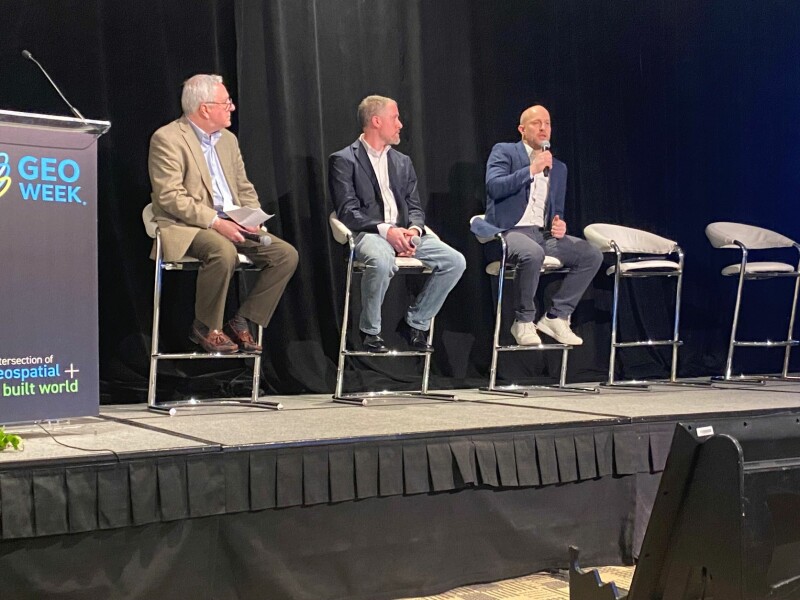“We need to look past the wow. It’s not the wow, it’s the what. What value are we getting from these?” That’s Ralph Coleman, Sales Director with Bluesky International, speaking about the next phase of digital twins and moving beyond the phase of being amazed by the tool and into expecting and searching for true value from them.
February 16-18, 2026 | Colorado Convention Center | Denver, CO, USAJoin Us at Geo Week 2026!
Still, there are many who continue to view the concept of a “digital twin” as a buzzword, especially when a significant chunk of the mainstream conversation around them revolves around the metaverse (speaking of buzzwords). Buzzword or no, digital twins are here and providing real value to those who are willing to take the leap and implement. This trend, which has really taken off over the last 18-24 months, brings together so much of the Geo Week community, so it makes sense that it was the topic of two separate sessions on the first day of the 2023 event at the Colorado Convention Center in Denver.
The first session, titled Digital Twins at scale, featured the following experts on a three-person panel:
- Ron Zahavi, Executive Director, Digital Twin Consortium, Chief Strategist for IoT Standards, Microsoft Azure IoT
- Tim Conroy, Northeast Field Technology Group Leader, DPR Construction
- Ralph Coleman, Sales Director, Bluesky International
Meanwhile, the second session, titled Empowering Digital Twins, featured the following six-person panel:
- Mark Oden, CEO, BIM Designs
- Stan Hennigh, Esri and Digital Twin Strategy Management Consultant, MG AEC Technology Partners/Team D3
- Adam Horn, Virtual Design & Construction - Team Leader, HNTB
- Ted Knaak, President, TopoDOT
- Raymond Mandli, Founder, Mandli Communications, Inc.
- Konrad Wenzel, Director Esri R&D Center Stuttgart, Esri
In attending each of these sessions, the clear theme that came through each conversation was that this is an area that is driving forward, and it’s taking with it anyone who is willing to come along for the ride. There were a few key themes in driving this industry forward, too. One of the most obvious, but also most crucial, is that it’s simply easier and more accessible to collect this data. Whether it’s GIS data which is as plentiful as ever from a number of different platforms, or laser scanning equipment for which the price has come down significantly, collecting the data which forms the foundation for these digital twins is no longer a massive outlay for a company.

Similarly, it’s easier than ever to bring together different types of data, be it from any combination of terrestrial laser scanning, mobile mapping, UAV mapping, photogrammetry, and aerial imagery. The combination of different data types allows for maximum accuracy on any project, and while this has always been the case until recently it was a tall task to seamlessly pull it all together. Now, software is available which can bring everything together, allowing not only for more accurate small-scale models – say, a building where a TLS can capture facades, UAVs can capture the roof, and mobile systems can collect data for the interior — but also larger scale.
And in addition to the increased accessibility, changing goals for all types of organization, both public and private, are leading to searches for tools that provide what digital twins can. Specifically, sustainability is top-of-mind for everyone. With the ability to create large-scale digital twins, something in which Coleman specializes and that Esri is assisting with in their newest platform, governments can have information about their domains to figure out where to focus their efforts to meet sustainability goals. Similarly, most every new construction project has those goals, and these digital twins can not only help track different key metrics during the construction process but also throughout the life of a building.
It wasn’t just the reasons for the growth in the space which was made clear in these conversations, either. Both panels highlighted that the value is being made clear to stakeholders who previously may have been hesitant to jump into this kind of technology. In the Empowering Digital Twins conversation in particular, multiple speakers highlighted the different kinds of conversations they’re having with customers around digital twins. Specifically, Hennigh talks about how owners have gone from a reactive mode – looking for solutions to current problems – to proactive, noting one client in particular doesn’t even have a specific plan for their digital twin at this point, but knows there is value in having it to solve future problems which have not yet arisen.
Meanwhile, in the Digital Twins at Scale conversation, Conroy talked about some of the benefits being seen in the construction industry that owners are noticing and taking advantage of. The main one is being able to detect clashes sooner by being able to compare as-built to plans on a consistent basis. It may not stop the error, but finding them earlier certainly saves both time and money in the long run. Additionally, he notes, that knowledge that the model will be able to find errors makes workers complete their projects a bit more carefully, much like the way a security camera often prevents wrongdoing.
Whether you want to consider it a buzzword or not, digital twins are here and they’re here to stay. More people than ever are finding value in them, and they are starting to become a demand rather than something an owner needs to be talked into. There’s no telling where this space could go just in the next year or two, never mind a decade down the line, but it’s hard not to be excited about the potential after attending these two sessions.






